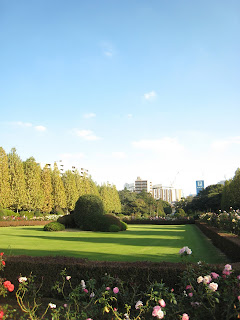 11月のはじめに京都に行ってきました。
11月のはじめに京都に行ってきました。目的は京都御所の秋季一般公開。
すばらしかったですが、すごい人でした。
I was in Kyoto again this month, mainly to visit Kyoto Imperial Palace.
Usually we can't go in the palace, but for a few days each in spring and autumn, it is open to the public..
It was magnifcent.
But as you can see, there were so many people......
清水寺にも行きましたよ。
壮大でしたが、すごい人でした。
I went to Kiyomizudera Temple.
It's dynamic..
But as you can see, there were so many people......as usual.
ちょっと疲れました。
I was quite tired......
そんな時銀閣寺の近くでほっとする庭園を見つけましたよ。
白沙村荘(はくさそんそう)です。
Then I found a very tranquil garden near Ginkakuji Temple.
It's called Hakusasonso.
 日本画家の橋本関雪(1883~1945)の住居。
日本画家の橋本関雪(1883~1945)の住居。「都市の中にあって深山に住むかのごとくひっそりと暮らす」
この理想を求めて、30年に渡り、自ら作り続けた庭だそうです。
It was a house of a Japanese-style artist Hashimoto Kansetsu(1883-1945).
"Living in a city, but as if living in a deep mountain."
Seeking this ideal, Kansetsu kept working on his garden for over 30 years.
 小さな茶室
小さな茶室A little tea-house on the pond.
竹の間に羅漢石仏が置かれていました。
お気に入りはいますか?
There were stone Rakan figures among bamboo trees.
Is there any you like?
 | |||||
| 考え事してます Thinking hard
|
白沙村荘にいる間、お客は私ひとり。
なんだか得した気持ちでゆったり散策できました。
京都で静かな場所をお探しなら、おすすめですよ。
While I was at Hakusasonso, I think I was the only visitor.
I felt lucky and enjoyed the beautiful garden.
If you need a quiet time in Kyoto, this might be a nice place to visit.

















































